About
- Provost’s Welcome
- About Eleanor
- History
- ERC People
- ERC Faculty
- Calendar
She was not only a “wife, mother, teacher, First Lady, world traveler, diplomat, and politician; she dedicated her life to human rights, civil rights, and international rights” (Eleanor Roosevelt: The American Experience). It is important to understand the struggles she faced because they greatly shaped the person she became. She overcame the hardships in her personal path and dedicated her life to helping others.
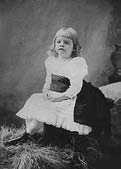
On October 11, 1884, Anna Eleanor Roosevelt was born into one of the oldest and wealthiest families in New York; nevertheless, her childhood was far from a fairy tale. Eleanor was shunned by her mother because she did not meet her standards; her mother even called her “Granny” when she was a little girl because she was not pretty enough to please her fashionable, party-loving mother. In contrast to her relationship with her mother, Eleanor as a teen was very close to her father. Before she was 11 years old, Eleanor was left a lonely orphan by her mother’s sudden death and her father’s death from alcoholism shortly afterward. For the remaining years of her childhood, Eleanor grew up with her grandmother, learning the importance of manners, being a young lady, and helping the less fortunate.
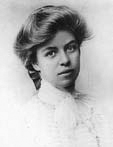
When she was a teenager, her grandmother sent her to Allenswood Academy, a boarding school in England. There Eleanor was happy for perhaps the first time. Marie Souvestre, the headmistress of Allenswood Academy, influenced Eleanor on the significance of public duty, and she became Eleanor’s first role model. After she returned to New York, Eleanor became involved with social work. When she was not yet 20 years old, she learned about the labor conditions of sweatshops and tenement housing. She was curious about everything and even walked on a picket line to express her concern and dedication for the rights of laborers. This marked the start of her life of public service, and she became a “voice for people who had none” (Eleanor Roosevelt: The American Experience). Despite the struggles she faced in her childhood, she took what she learned from Souvestre, and decided to help others who were less fortunate. Even though she was born into the wealthy class, “she transcended the limitations of her background and became a champion of those who, as a child, she would perhaps not even have acknowledged” (Flemion and O’Connor 1).
Eleanor Wedding Day
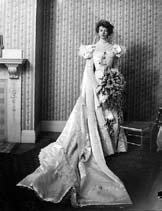
Once the family moved back to New York, Eleanor jumped right in and joined numerous women’s clubs, where she met many other independent women. However, the family faced yet another obstacle when FDR was diagnosed with polio. FDR never regained the use of his legs. His mother wanted him to retire from politics. Eleanor, however, supported him and encouraged him not to give up. While FDR was recovering in a physical therapy facility in Warm Springs, Eleanor became more involved with her own work. She started the Todhunter School for Girls, expressing her love for teaching by saying, “I teach because I love it. I cannot give it up” (Black 16). She founded a factory at Val-Kill cottage in Hyde Park, which provided jobs for unemployed workers. Eleanor also fought for women’s rights and full political participation.
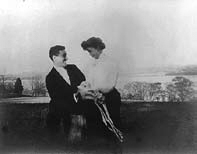 Many of her close friends were feminists and progressives. After FDR became Governor of New York, Eleanor started working for the Democratic Party, and the media considered her a “woman [of influence] who speaks her political mind” (Black 10). By 1922, Eleanor was the vice president and finance chairman of the Democratic Women’s Committee. She became very involved in all aspects of politics, and even “stuff[ed] envelopes and [drove] voters to the polls,” to promote the democratic spirit (Black 12). In 1924, Eleanor joined the Women’s City Club, where they focused on child labor laws and worker’s compensation.
Many of her close friends were feminists and progressives. After FDR became Governor of New York, Eleanor started working for the Democratic Party, and the media considered her a “woman [of influence] who speaks her political mind” (Black 10). By 1922, Eleanor was the vice president and finance chairman of the Democratic Women’s Committee. She became very involved in all aspects of politics, and even “stuff[ed] envelopes and [drove] voters to the polls,” to promote the democratic spirit (Black 12). In 1924, Eleanor joined the Women’s City Club, where they focused on child labor laws and worker’s compensation.
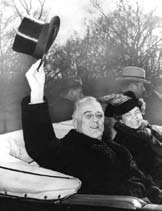
Even after FDR became President of the United States, Eleanor refused to lose her independence. She was not sure what life would be like in the White House, and she dreaded the role of First Lady, declaring, “I never wanted to be a President’s wife” (Black 20). Nevertheless, she supported FDR to demonstrate her loyalty to her husband and the Democratic Party. In 1933, when they entered the White House, FDR asked Eleanor to resign from her outside positions, and that contributed to her struggles in adapting to the White House. However, she toured the country during the Great Depression and acted as her “husband’s ears and legs,” as she learned about the widespread hunger and sorrow (Eleanor Roosevelt: A Restless Spirit). Traveling across the country, she was FDR’s ambassador, and this helped her become more visible, outspoken, and involved. As a public figure, she was not like previous First Ladies. Since FDR was confined to his wheelchair, he sent Eleanor out to see people and to talk about his plans. Eleanor brought many issues to FDR because she wanted him to be more aware of everything that was happening throughout the country.
Eleanor and FranklinDuring FDR’s first year as President, Eleanor traveled over 40,000 miles, where she experienced poverty first hand; consequently, she wanted to bring attention to the poor living conditions that many Americans faced (Eleanor and Franklin: The White House Years). She encouraged him to give women positions in the White House and in fact was the first to invite women journalists to the White House. Many times, FDR would get angry and annoyed when Eleanor would ask him to read over things, but she wanted him to get more involved with certain issues that she felt were important; similarly, “although [Eleanor], like most white Americans grew up in an environment suffused with racist and nativist attitudes, by the time she reached the White House, she was one of the few voices in the administration insisting that racial discrimination had no place in American life” (Flemion and O’Connor 7). Eleanor wrote a daily newspaper column, “My Day,” which was published in 180 newspapers nationwide. From 1936-1945, “she wrote… more than 2,500 columns, and 200 articles, published six books, and delivered at least 70 speeches a year” (Black 47). She used “My Day” as a political forum because she wanted to express awareness of foreign policy and wars. In one of her columns she wrote, “I think women of this country… will agree with me that this is a time for action--not for war, but for mobilization of every bit of peace machinery” (Roosevelt, Eleanor Roosevelt’s My Day, 34-45). In order to express her concerns and to get her point across, many times she was blunt.
By emphasizing her dislike for segregation, she helped promote the importance of equality, stating that “freedom must be universal and all men must be assured that there will be respect for the individual human being, regardless of his race, his creed, or his color” (Roosevelt, Eleanor Roosevelt’s My Day, 76). She was also very open about her life, and made it seem like her readers were right there with her; in her columns, she would share stories about her day-to-day life, and even give advice. Eleanor strongly encouraged people to write to her, and within the first year of her column, she received over 300,000 letters; she frequently responded to people’s letters in her columns in order to help bring attention to certain issues. From reading through some of her columns, it is evident that Eleanor was very down to earth and inspirational; even though she was wealthy for most of her life, she emphasized that “one of the real gifts that brings you riches… is the power of appreciation” (Roosevelt, Eleanor Roosevelt’s My Day, 57).
Although FDR and Eleanor seemed very close to one another in the public’s eyes, they actually led somewhat parallel lives. They had more of a political partnership; she admitted that “partnership is the major requirement for modern marriage” (Black 14). Missy LeHand, FDR’s secretary, often spent more time with FDR than Eleanor did. Eleanor’s marriage did not keep her from participating in public life and following her own path. During her years as First Lady, she continued to help those who were unable to help themselves, which definitely shaped her legacy. One of the issues that she addressed was the problem of unemployed youth. FDR created the Civilian Conservation Corps (CCC), but Eleanor did not support that program wholeheartedly because she thought it was too militaristic. Instead, she worked with student leaders and relief officials to create programs she liked better. Consequently, FDR ultimately formed the National Youth Administration, which focused on work projects, vocational training, apprenticeship training, educational and nutritional camps for women, and student aid. She also encouraged governmental support for art by supporting the establishment of the Federal Writers Project (FWP), Federal Theater Project (FTP), and Federal Art Project (FAP). But she is best known for reaching out to the minorities and the poor. Even when she was criticized by the media, she never backed down from her stand against racial injustice.
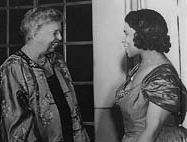
In 1939, after the Daughters of American Revolution refused to let the world-renowned African American contralto Marian Anderson sing in their Constitution Hall, Eleanor resigned from the group. To express her support for Anderson, Eleanor arranged for her to sing at the Lincoln Memorial. An estimated 75,000 people listened from around the Reflecting Pool on the National Mall between the Lincoln Memorial and the Washington Monument (Somerville 148). Eleanor Roosevelt was not only an outspoken advocate for civil rights, she was a well respected public speaker. Even though she was terrified of public speaking at first, she became one of the most effective public speakers of the 20th Century.
She also continued fighting for civil rights and human rights during World War II. Eleanor visited the troops overseas, and was nicknamed “Rover.” On those tours she would always wear her Red Cross uniform. She emphasized that “every man who fights for us, is our man,” stressing the insignificance of race and religion (Eleanor Roosevelt: A Restless Spirit). And whenever she visited the troops, she spent time with all the enlisted men and visited the wounded soldiers to give them hope. During these years, Eleanor also defended the Japanese-Americans, despite FDR’s opinion. To show her support, she visited the Japanese internment camps and expressed the need for racial tolerance, especially when she said that it was wrong for “innocent people [to] suffer for the few guilty ones” (Black 146). Eleanor stayed involved with public work throughout her years as First Lady. On April 12, 1945, Eleanor was away at a fundraiser the night that FDR died. She was devastated by his death and to learn that his former lover Lucy Mercer Rutherford was by FDR’s side. Eleanor and Human Rights
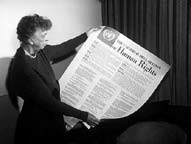
Although she struggled with the loss of her husband, on her own Eleanor gained even more freedom to express herself. President Harry S. Truman appointed her as a U.S. delegate for the United Nations, where she became an outspoken advocate for world peace. For the United Nations, Eleanor traveled all over the world, helped open the headquarters of the San Diego chapter, and played a major part in drafting and gaining passage for the Universal Declaration of Human Rights, which she considered her most notable achievement. During Truman’s presidency, her stance on civil rights evolved because “for the first time, Eleanor Roosevelt recognized the issues concerning blacks as a race problem; earlier she had considered them mainly in the context of social justice” (Flemion and O’Connor 166).
In 1945, she had joined the NAACP, increasing her involvement in the civil rights movement. Eleanor hated violence and especially detested lynching. She worked with Thurgood Marshall and helped with housing and community planning for African Americans. “Black Americans appreciated Eleanor Roosevelt’s unflinching connection of housing rights to civil rights” (Black 104). She also supported the Congress on Racial Equality (CORE) and fought against the discrimination and segregation of public schools. When she visited the segregated First Methodist Church in Birmingham, Alabama, she refused to sit on either the white or black side and had her chair placed in the center aisle between two sides. Throughout the 1950s, Eleanor Roosevelt was interviewed frequently on radio and television, and she used such programs to promote different causes. Eleanor continued to work for the Democratic Party, and emphasized that civil rights and civil liberties were the most important aspects of democracy. As she became older, she became even more liberal in her outlook. Some of her critics even accused her of being responsible for black riots.
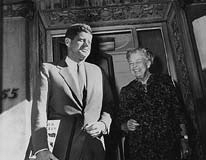
Eleanor and JFKThe FBI had a file on her of over 4,000 pages which contained her letters and her work, including her controversial opinions against racism and lynching. During the “Red Scare” about Communism in America throughout the 1950’s, Eleanor was caught in the middle. She defended the students accused of being Communists because she saw them as idealists, and she stressed their right to freedom of speech. Although she was anti-Communist, she strongly disagreed with Senator Joseph McCarthy’s tactics of accusing people, especially students, of being un-American if they supported liberal causes. To win the 1960 Democratic nomination, Senator John F. Kennedy knew that he needed to gain Eleanor’s support. The Democratic Party was split on the issue of civil rights. Eleanor wanted Adlai Stevenson to win the Democratic nomination that year, but Kennedy was nominated instead. Kennedy had to go to Val-Kill to gain Eleanor’s support, because he wanted to win the votes of African Americans. After he was elected President, Eleanor was disappointed that Kennedy’s administration was not initially supportive of civil rights in general and the Freedom Riders in particular – causes which were very important to her. She was, on the other hand, delighted with the creation of the Peace Corps under Kennedy’s influence and became an enthusiastic supporter of the agency. President Kennedy appointed her to the Peace Corps Advisory Board and to the chairmanship of the President’s Commission on the Status of Women.
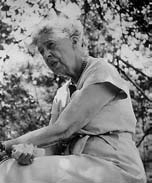
Throughout her life, Eleanor fought for issues that she felt were necessary to address, like racial equality and worldwide Eleanorhuman rights. She served on the Board of the NAACP and “labeled racial prejudice undemocratic and immoral” (Black, 37). After World War II, Eleanor focused on racial discrimination, not just in the U.S., but internationally as well. By fighting for worldwide human rights, Eleanor became known as the “First Lady of the World.” She continued “discussing their problems in her speeches, columns, and articles,” and fought for human rights both nationally and abroad (Black 94). Ever since she was young, she had believed that everyone has the right to speak his or her mind, and in her last book, Tomorrow is Now, she stressed the necessity of individual action. By emphasizing the fact that one should not do just what everyone else is doing, she wrote, “we have to learn to think freshly about our new revolutionary world, to free our intelligence from the shackles of fear, and set it to work on the most challenging problem we have ever faced: the preservation of civilization” (Roosevelt, Tomorrow is Now, 26). Along with emphasizing the ideas that the state is supposed to serve the people and the citizens are supposed to be informed, she expressed the importance of having respect for other nations and other people.
She remained intensely involved with the United Nations because she saw the organization as a “reflection of the whole world,” which was very important to her (Roosevelt, Tomorrow is Now, 113). Eleanor Roosevelt died on November 7, 1962 at the age of 78. When remembering their mother, her children stated, “we were the most important thing in her life in our opinion-- and that’s the way she made everybody throughout the world feel” (Flemion and O’Connor, 44).